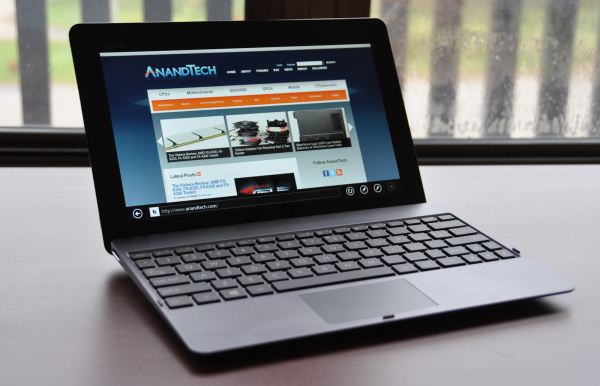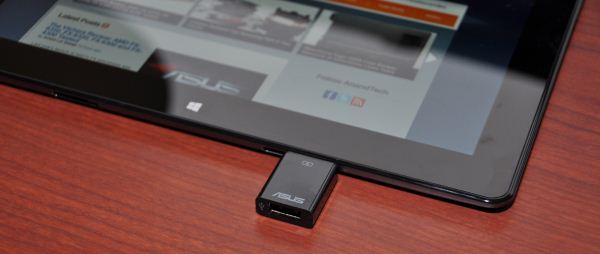ASUS VivoTab RT Review
by Vivek Gowri on October 23, 2012 3:01 PM EST- Posted in
- Asus
- Mobile
- Tablets
- Windows RT
- Vivo Tab
The ASUS Transformer line of tablets have consistently been among the strongest contenders in the Android tablet world, so when it was announced that they would be one of the launch partners for Microsoft’s Windows-on-ARM push, big things were expected. And so we have the ASUS VivoTab RT. The VivoTab name comes from the Latin verb “to live”, while the RT part is of course an indication of Windows RT, the official name for the ARM version of Windows. Windows RT-based tablets are Microsoft’s first real competitors built for the modern tablet market, so this is a hugely important launch for Microsoft as well as its hardware partners. Obviously the elephant in the room here is Surface and how Microsoft entering the hardware market changes the Windows 8/RT launch, but we’ll get to that part in time.
The division of Windows 8 (x86) and Windows RT (ARM) has resulted in a whole host of tablets with names ending in RT, and very similarly named examples running the x86-based Windows 8, so it’s worth keeping track of. For example, the VivoTab is x86-based, with Windows 8, Clover Trail, and an 11.6” display, a completely different product than the VivoTab RT that we have in front of us today. The RT is very important in making the distinction between ARM and x86 hardware platforms.
At first glance, the VivoTab RT looks pretty similar to what we’re used to seeing from the Transformer line, with a 10.1” IPS 768p display housed in a slim aluminum chassis and Nvidia’s Tegra 3 silicon underhood. The specsheet is actually pretty similar to the original Transformer Prime from last December, sharing identical width and thickness dimensions in addition to the obvious hardware-level similarities. The Transformer tablets have all been either 1280x800 or 1920x1200, so the switch to a 16:9 screen has allowed ASUS to make the VivoTab RT a bit shorter, as well as 60g lighter, than the Transformer Prime. At 1.15lbs, the VivoTab RT is quite the featherweight, helped along in this by the nano molding technology that injects liquid plastic to fuse the aluminum frame with the plastic components.
| Tablet Specification Comparison | ||||||
| ASUS VivoTab RT | Microsoft Surface for Windows RT | ASUS Eee Pad Transformer Prime | ASUS Transformer Pad Infinity | |||
| Dimensions | 263mm x 171mm x 8.3mm | 275 x 172 x 9.4mm | 263 x 180.8 x 8.3mm | 263 x 180.6 x 8.4mm | ||
| Chassis | Aluminum + Plastic | Magnesium | Aluminum | Aluminum + Plastic | ||
| Display | 10.1-inch 1366 x 768 Super IPS+ | 10.6-inch 1366 x 768 | 10.1-inch 1280 x 800 Super IPS+ | 10.1-inch 1920 x 1200 Super IPS+ | ||
| Weight | 525g | 680g | 586g | 594g | ||
| Processor | 1.3GHz NVIDIA Tegra 3 (T30 - 4 x Cortex A9 |
1.3GHz NVIDIA Tegra 3 (T30 - 4 x Cortex A9 |
1.3GHz NVIDIA Tegra 3 (T30 - 4 x Cortex A9) |
1.6GHz NVIDIA Tegra 3 (T33 - 4 x Cortex A9) |
||
| Memory | 2GB | 2GB | 1GB | 1GB DDR3-1600 | ||
| Storage | 32/64GB + microSD slot | 32/64GB + microSD slot | 32GB/64GB + microSD slot | 32/64GB + microSD slot | ||
| Battery | 24.4Whr | 31.5Whr | 25Whr | 25Whr | ||
| Pricing | $599/699 (includes dock) | $499/599 | $499/$599 | $499/$599 | ||
The heart of the VivoTab RT is a 1.3GHz T30, the same chip as the Transformer Prime and international HTC One X, amongst other devices. It’s paired with 2GB of DDR3L memory, 32GB of NAND storage, 2.4GHz 802.11n, Bluetooth 4.0, cameras front (2MP) and back (8MP with an LED flash and 1080p video), a 10.1” 1366x768 Super IPS+ panel, and a 25Wh battery. In addition, it has a microSD card slot, a micro-HDMI port, and the proprietary charging/dock connector. The port itself is different from the ones on the Transformers, the VivoTab RT uses a smaller and lower-profile connector. Included in the box is a USB 2.0 dongle that connects up to the dock connector. It’s a bit unwieldy, but it’s better than not having any options for USB support.
When the VivoTab RT went up for preorder, it was priced at $599/699 for the 32GB and 64GB versions, respectively, with various online retailers offering a pre-order bundle with the 32GB VivoTab RT and the laptop dock together for $749. Shortly before this review went live, however, I received an email from ASUS saying that final pricing would be $599 for the 32GB model including the docking station, with most of the focus being on selling the bundle rather than the individual pieces. This was likely a response to the more aggressive pricing of the Surface RT, which offers similar hardware for $499 (32GB), or $599 when bundled with the Touch Cover keyboard case. It’s good to see ASUS adjust to Microsoft’s pricing this quickly, but I’m not sure there was much of a choice there if they wanted to be competitive. The laptop dock is more functional than Microsoft’s keyboard covers and throws in a near-doubling of battery capacity for good measure, so the new pricing quickly turns the VivoTab RT into a good value.












68 Comments
View All Comments
frostyfiredude - Tuesday, October 23, 2012 - link
Surface RT has a 10% larger display, but a 30% larger battery. Processor power usage should remain constant even with the larger display, so the power usage won't actually go up 10%, but somewhere lower like 7 or 8%.Considering those two, wouldn't it make sense that Surface RT actually gets greater battery life than an un-docked VivoTab RT? Supposedly Surface engineers are hitting 12 hours of usage with it, which seems about right to me at 18-33% greater life than the Vivo RT here.
ssiu - Tuesday, October 23, 2012 - link
"but even compared to Clover Trail, Tegra 3 is not that fast""But given how well RT runs on quad-core Cortex A9, I’m just eager to see shipping devices with faster SoCs - Krait and Clover Trail in the coming weeks, A15 in the not-too distant future. "
I already think "Atom == slow" (poor experience with early netbook). If Windows RT tablets are slower than Windows 8 Atom tablets than I don't know why anyone would choose the former. Even if Krait or A15 is a bit faster than Clover Trail, personally I'd still choose x86 compatibility.
Urizane - Tuesday, October 23, 2012 - link
Early netbook slowness depends on more than just the CPU. A large majority of early netbooks had very little RAM as well as slow hard drives. These days, there's a lot more RAM as well as solid state storage. I remember old Atom 330 machines that you could upgrade from 1 GB of RAM to 2 GB that made a pretty sizeable difference in day-to-day use. Upgrading to an SSD makes application load times even better. The CPU wasn't fast, but it also wasn't the only reason people hated early netbooks.Impulses - Friday, October 26, 2012 - link
More RAM and a SSD worked wonders even for first gen Atom netbooks (single core)... For a tablet workflow it's not really any worse than current ARM SoC, now if you're trying to use it as a laptop replacement that's another story. I think that term is gonna get thrown around too easily with these hybrid Win RT devices...Even looking past the dire lack of apps (beyond Office), raw performance isn't where it needs to be to make such a concept reality, performance's obviously not gonna be there until A15/S4 Pro/next gen Atom. Laptop alternative might be the more accurate term, tho it's all obviously very dependent on your particular needs.
powerarmour - Thursday, October 25, 2012 - link
You need to bear in mind the graphics capabilities of Tegra 3 vs Clover Trail, Clover Trail is looking like it's going to be a mess on those regards, with Intel yet again failing to deliver a PowerVR driver of any decent quality.What good is a slightly better CPU, when the only thing 3D it can run is the Metro desktop?
Relic74 - Tuesday, January 1, 2013 - link
I just bought the Asus 810c Vivo, though I to have had bad experience with a Atom CPU netbook from Nokia I am quite impressed as to how snappy the OS is. I'm a programmer so the only desktop apps I really use are Netbeans, Java SDK, FileZilla, Bittorent, OpenOffice, Gimp, Inkscape, Thunderbird, Firefox, XAMPP and Google Earth. All run extremely well but I can't express to you guys enough how fast Windows 8 fly's on this system and that battery, wow, 17.5 hours. I literary charge it ounce every 4 days. As a road machine it's bar none one of the best laptops I have ever owned. I'm digging the Vivo a lot and I'm starting to appreciate Microsoft tablet vision.I see how a lot of you get caught up in benchmarks but when you travel as much as I do it's all about longevity, my other laptop is a Lenovo X220T and even with a batter slice I still barely get about 7 hours.
Flunk - Tuesday, October 23, 2012 - link
This review is great and it's good to see ARM powered Windows in a real device... But I (and I'm sure other readers) would love to see a review of the newly announced Asus Zenbook U500VZ. It sounds like a really interesting device, and touch sounds a little strange on a 15" device.Just hoping you guys do a review, you guys are one of the most reputable sources for reviews.
dananski - Tuesday, October 23, 2012 - link
30% CPU usage from typing in Word 2013 doesn't surprise me - I've had 2013 on my new i7 desktop for a while and I sometimes get lags while typing in Word or clicking around in Excel. Don't try to move the windows around the screen - some very dodgy performance issues there; I used the feedback button to highlight a few.I wonder if these performance issues will make it into the release version. Back when I got Office 2007 there were a few times when performance went terrible in Excel, which they fixed in SP1. Here's hoping that's not going to be the case again...
cmdrdredd - Tuesday, October 23, 2012 - link
Might compete well with a Transformer Infinity in benchmarks but it needs apps.B3an - Tuesday, October 23, 2012 - link
Nice review. And i agree with everything said in it. This looks like a good device and i'd easily choose it over an iPad or Android tablet, but i'll likely go with a Win 8/x86 tablet.